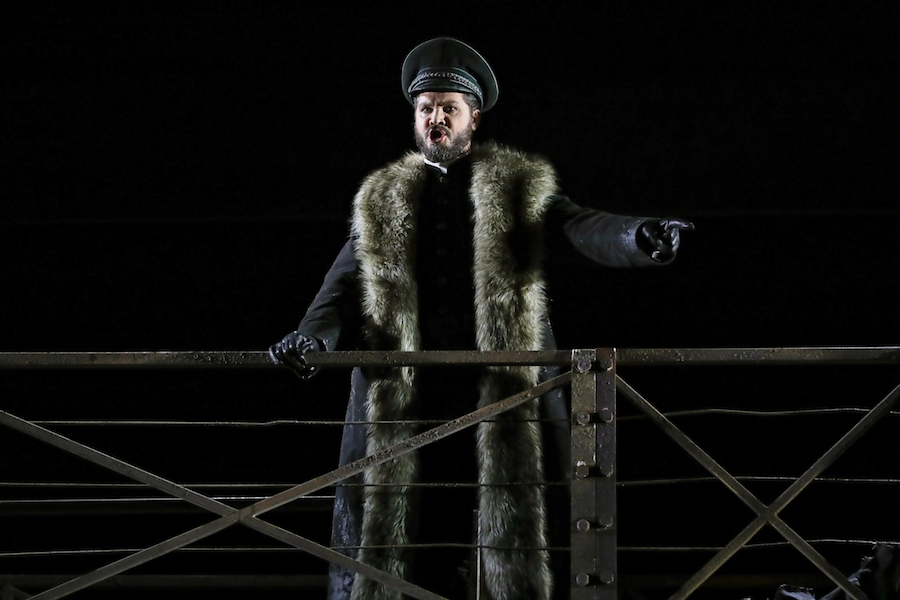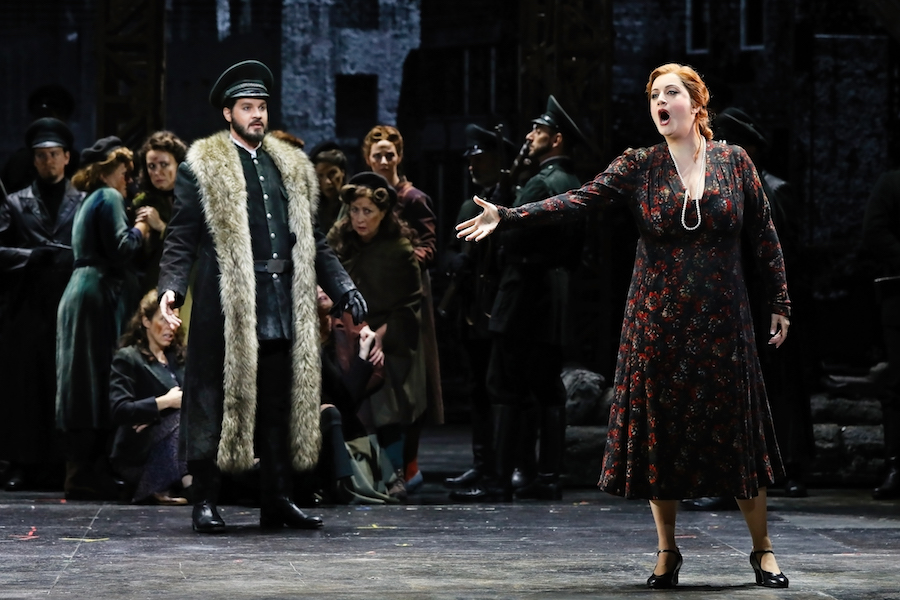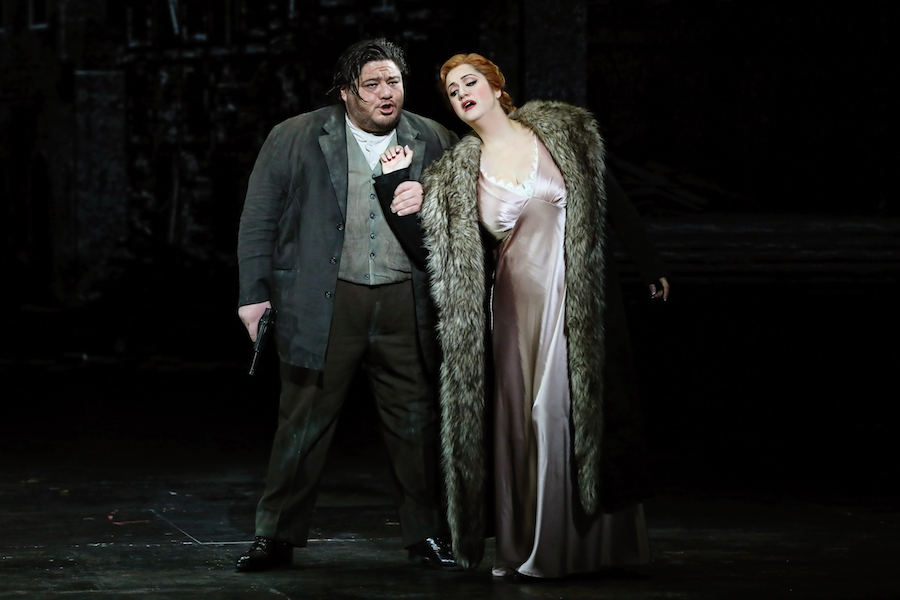Attila is far from Verdi at the peak of his powers. It’s much less sophisticated than the composer’s following work, Macbeth, both in terms of narrative and music, with lots of orchestral oompahing and solo moments that can feel perfunctory. Despite these things, it’s become one of the most frequently staged of Verdi’s early operas, and it’s not hard to see why. A compact showcase for a quartet of powerhouse singers, it’s essentially a melodrama about the assassination of Attila the Hun. What leads to his grisly end? Love, of course. Having conquered Italy, our fearsome warrior falls head over heels for Odabella, daughter of a slain leader. Unfortunately for him, she’s only pretending to accept her fate as Attila’s concubine in order to see him killed, going so far as to thwart a separate assassination attempt to reserve that privilege for herself.
 Taras Berezhansky in Opera Australia’s Attila. Photo © Prudence Upton
Taras Berezhansky in Opera Australia’s Attila. Photo © Prudence Upton
None of this works if you don’t have a cast able to meet Verdi’s significant vocal demands, or a production that really tries to make something more out of Temistocle Solera’s blunt libretto. While Opera Australia mostly delivered on the former, this co-production with La Scala from Davide Livermore struggled to make a satisfying whole out of the opera’s episodic, sketch-like nature. I wasn’t a fan of Livermore’s digital stagings of Aida and Anna Bolena, finding his use of the technology only intermittently visually exciting and often an obstacle to meaningful storytelling. This production, transplanting the action to 1940s Italy, hasn’t changed my belief that Livermore tends to emphasise style over substance, the distracting use of live horses one such example. While his deployment of the LED screens is better integrated here with the physical sets, the imagery continues to swing between the blandness of a computer screensaver, and the overdetermined, as with footage of a young Odabella witnessing the murder of her father.
Livermore’s direction and blocking of the singers also continues to trade in stock operatic gestures, and his use of quick freeze frames feels just as hackneyed. The opera’s climax drew a huge, unintended laugh from the audience, a reaction that could have been easily avoided had the blocking not been so clumsy. A surer directorial hand might also have paid closer attention to the characters’ relationships with one another, so key to the opera, or display a greater interest in the tension between nationalism and freedom, one of Verdi’s enduring preoccupations. For the most part, the opera just happens, and the characters are flattened figures that don’t define or transcend the action. For an opera with such a large canvas, that paints with such broad strokes, the stakes remain bewilderingly small in Livermore’s hands.
 Taras Berezhansky and Natalie Aroyan in Opera Australia’s Attila. Photo © Prudence Upton
Taras Berezhansky and Natalie Aroyan in Opera Australia’s Attila. Photo © Prudence Upton
Thankfully there’s some fantastic singing to be had, beginning with Ukrainian bass Taras Berezhansky in the title role. In my 2019 Bohème review of his Colline, I wrote, “[here’s] a beautifully weighty instrument that has exciting repertoire options ahead of it” and I’m glad to be proven correct. At 34, he’s certainly very young to be singing Attila, and his lyric-leaning voice as of yet is missing some of the thrust and power that will come with time. What he currently brings to the role is firm, resonant tone with plenty of vocal colour, and he occupies the stage with charisma and easy authority. His dream scene was a true highlight, melding menace with moments of vulnerability and pathos.
Making her debut as Odabella, company favourite Natalie Aroyan had ample opportunity to demonstrate the many qualities of her impressive soprano. Round and richly coloured, with plenty of metal and an impressive chest register, it’s the kind of spinto voice that doesn’t come along all that often. But like Berezhansky, she’s young to be tackling such a demanding role, and she unsurprisingly lacks some of the polish that will again accrue with time – some of the coloratura was tentative, while the extremes of her range weren’t as well supported as her middle voice. Yet she brought plenty of dramatic panache to the vengeful Odabella, and the Act 1 romanza, Oh! Nel fuggente nuvolo, was a model of Verdian sweep and line. This was a very promising debut indeed, and I can’t wait to see her take on the composer’s Leonoras or Elisabetta.
 Diego Torre and Natalie Aroyan in Opera Australia’s Attila. Production © Prudence Upton
Diego Torre and Natalie Aroyan in Opera Australia’s Attila. Production © Prudence Upton
In another role debut, Diego Torre offered some of the night’s most ravishing singing as Odabella’s betrothed, Foresto. His sweet timbre, easy projection, and facility with the language and line elevated this most cardboard cut-out of tenor heroes, and his Act III curtain raiser Che non avrebbe il misero was gorgeously expansive and throbbing with emotion. In his house debut, Italian baritone Simone Piazzola brought a similar linguistic authority, as well as a glamorous sonority, to the Roman General Ezio. While Piazzola generally played to the rafters, which Livermore could have curtailed, he made for a formidable opponent in his duet with Attila, despite some brief moments of unfocused singing elsewhere. Tenor Virgilio Marino and bass Gennadi Dubinsky provided key support as Uldino and Pope Leo I respectively.
The Opera Australia Chorus were ardent and well-drilled, judging from the precision with which they handled entrances and exits as well as offstage passages. And in the pit, conductor Andrea Licata made something of even Verdi’s more routine accompaniments, bringing out the qualities that anticipate the composer’s genius in its maturity through immaculate balance and unflagging momentum.
Opera Australia’s Attila is at the Sydney Opera House until March 28












Comments
Log in to join the conversation.